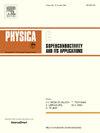Spin-triplet f-wave pairing via cyclic exchange in the anisotropic triangular Hubbard model: A route to unconventional superconductivity
IF 1
3区 物理与天体物理
Q4 PHYSICS, APPLIED
Physica C-superconductivity and Its Applications
Pub Date : 2025-05-29
DOI:10.1016/j.physc.2025.1354742
引用次数: 0
Abstract
We investigate the interplay between ferromagnetism and unconventional superconductivity in a two-dimensional anisotropic triangular-lattice Hubbard model using the density-matrix renormalization group (DMRG) method. A novel mechanism for spin-triplet f-wave superconductivity is identified, driven by three-site cyclic-exchange interactions. This mechanism highlights the crucial role of lattice anisotropy and triangular hopping networks in stabilizing ferromagnetic correlations necessary for spin-triplet pairing. The slow decay of pair-correlation functions and their sign change under a rotation confirm the dominant f-wave symmetry of the superconducting state. These findings offer a unified theoretical framework for understanding unconventional superconductivity in strongly correlated electron systems, with potential relevance to materials such as Bechgaard salts , cobalt oxide , and layered perovskite .
各向异性三角形Hubbard模型中通过循环交换的自旋三重态f波配对:非常规超导的一条途径
利用密度矩阵重整化群(DMRG)方法研究了二维各向异性三角晶格Hubbard模型中铁磁性和非常规超导之间的相互作用。发现了一种由三位点循环交换相互作用驱动的自旋三重态f波超导新机制。这一机制突出了晶格各向异性和三角跳变网络在稳定自旋三重态配对所需的铁磁相关中的关键作用。对相关函数在π/3旋转下的缓慢衰减及其符号变化证实了超导态的主要f波对称性。这些发现为理解强相关电子系统中的非常规超导性提供了一个统一的理论框架,与Bechgaard盐(TMTSF)2X、氧化钴Na0.35CoO2⋅1.3H2O和层状钙钛矿Sr2RuO4等材料具有潜在的相关性。
本文章由计算机程序翻译,如有差异,请以英文原文为准。
求助全文
约1分钟内获得全文
求助全文
来源期刊
CiteScore
2.70
自引率
11.80%
发文量
102
审稿时长
66 days
期刊介绍:
Physica C (Superconductivity and its Applications) publishes peer-reviewed papers on novel developments in the field of superconductivity. Topics include discovery of new superconducting materials and elucidation of their mechanisms, physics of vortex matter, enhancement of critical properties of superconductors, identification of novel properties and processing methods that improve their performance and promote new routes to applications of superconductivity.
The main goal of the journal is to publish:
1. Papers that substantially increase the understanding of the fundamental aspects and mechanisms of superconductivity and vortex matter through theoretical and experimental methods.
2. Papers that report on novel physical properties and processing of materials that substantially enhance their critical performance.
3. Papers that promote new or improved routes to applications of superconductivity and/or superconducting materials, and proof-of-concept novel proto-type superconducting devices.
The editors of the journal will select papers that are well written and based on thorough research that provide truly novel insights.

 求助内容:
求助内容: 应助结果提醒方式:
应助结果提醒方式:


